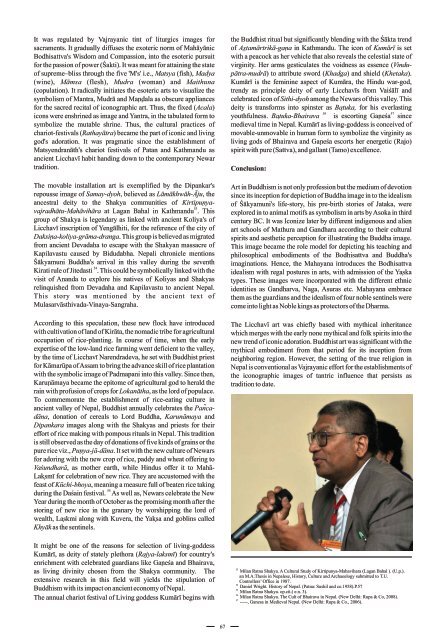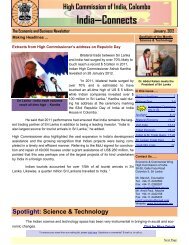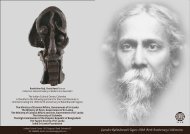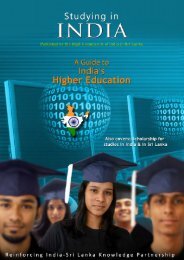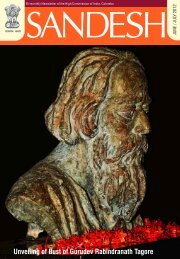Papers presented at the International Buddhist Conference, March ...
Papers presented at the International Buddhist Conference, March ...
Papers presented at the International Buddhist Conference, March ...
You also want an ePaper? Increase the reach of your titles
YUMPU automatically turns print PDFs into web optimized ePapers that Google loves.
̣<br />
It was regul<strong>at</strong>ed by Vajrayanic tint of liturgics images for<br />
sacraments. It gradually diffuses <strong>the</strong> exoteric norm of Mahāyānic<br />
Bodhis<strong>at</strong>tva's Wisdom and Compassion, into <strong>the</strong> esoteric pursuit<br />
for <strong>the</strong> passion of power (Śakti). It was meant for <strong>at</strong>taining <strong>the</strong> st<strong>at</strong>e<br />
of supreme–bliss through <strong>the</strong> five 'M's' i.e., M<strong>at</strong>sya (fish), Madya<br />
(wine), Māmsa (flesh), Mudra (woman) and Maithuna<br />
(copul<strong>at</strong>ion). It radically initi<strong>at</strong>es <strong>the</strong> esoteric arts to visualize <strong>the</strong><br />
symbolism of Mantra, Mudrā and Mand ̣ ạla as obscure appliances<br />
for <strong>the</strong> sacred recital of iconographic art. Thus, <strong>the</strong> fixed (Acala)<br />
icons were enshrined as image and Yantra, in <strong>the</strong> tabul<strong>at</strong>ed form to<br />
symbolize <strong>the</strong> mutable shrine. Thus, <strong>the</strong> cultural practices of<br />
chariot-festivals (R<strong>at</strong>hayātra) became <strong>the</strong> part of iconic and living<br />
god's ador<strong>at</strong>ion. It was pragm<strong>at</strong>ic since <strong>the</strong> establishment of<br />
M<strong>at</strong>syendranāth's chariot festivals of P<strong>at</strong>an and K<strong>at</strong>hmandu as<br />
ancient Licchavī habit handing down to <strong>the</strong> contemporary Newar<br />
tradition.<br />
The movable install<strong>at</strong>ion art is exemplified by <strong>the</strong> Dipankar's<br />
repousse image of Samay-dyoh, believed as Lāmākhwāh-Āju, <strong>the</strong><br />
ancestral deity to <strong>the</strong> Shakya communities of Kirtipunỵa-<br />
53<br />
vajradhātu-Mahāvihāra <strong>at</strong> Lagan Bahal in K<strong>at</strong>hmandu . This<br />
group of Shakya is legendary as linked with ancient Koliya's of<br />
Licchavī inscription of Yengālhiti, for <strong>the</strong> reference of <strong>the</strong> city of<br />
Daksinạ-koliya-grāma-dranga. This group is believed as migr<strong>at</strong>ed<br />
from ancient Devadaha to escape with <strong>the</strong> Shakyan massacre of<br />
Kapilavastu caused by Bidudabha. Nepali chronicle mentions<br />
Śākyamuni Buddha's arrival in this valley during <strong>the</strong> seventh<br />
54<br />
Kir<strong>at</strong>i rule of Jitedasti . This could be symbolically linked with <strong>the</strong><br />
visit of Ananda to explore his n<strong>at</strong>ives of Koliyas and Shakyas<br />
relinquished from Devadaha and Kapilavastu to ancient Nepal.<br />
This story was mentioned by <strong>the</strong> ancient text of<br />
Mulasarvāsthivada-Vinaya-Sangraha.<br />
According to this specul<strong>at</strong>ion, <strong>the</strong>se new flock have introduced<br />
with cultiv<strong>at</strong>ion of land of Kirāta, <strong>the</strong> nomadic tribe for agricultural<br />
occup<strong>at</strong>ion of rice-planting. In course of time, when <strong>the</strong> early<br />
expertise of <strong>the</strong> low-land rice farming went deficient to <strong>the</strong> valley,<br />
by <strong>the</strong> time of Licchavī Narendradeva, he set with <strong>Buddhist</strong> priest<br />
for Kāmarūpa of Assam to bring <strong>the</strong> advance skill of rice plant<strong>at</strong>ion<br />
with <strong>the</strong> symbolic image of Padmapani into this valley. Since <strong>the</strong>n,<br />
Karuṇāmaya became <strong>the</strong> epitome of agricultural god to herald <strong>the</strong><br />
rain with profusion of crops for Lokanātha, as <strong>the</strong> lord of populace.<br />
To commemor<strong>at</strong>e <strong>the</strong> establishment of rice-e<strong>at</strong>ing culture in<br />
ancient valley of Nepal, <strong>Buddhist</strong> annually celebr<strong>at</strong>es <strong>the</strong> Pañcadāna,<br />
don<strong>at</strong>ion of cereals to Lord Buddha, Karunāmaya and<br />
Dipankara images along with <strong>the</strong> Shakyas and priests for <strong>the</strong>ir<br />
effort of rice making with pompous rituals in Nepal. This tradition<br />
is still observed as <strong>the</strong> day of don<strong>at</strong>ions of five kinds of grains or <strong>the</strong><br />
pure rice viz., Punỵa-jā-dāna. It set with <strong>the</strong> new culture of Newars<br />
for adoring with <strong>the</strong> new crop of rice, paddy and whe<strong>at</strong> offering to<br />
Vaśundharā, as mo<strong>the</strong>r earth, while Hindus offer it to Mahā-<br />
Laksmī for celebr<strong>at</strong>ion of new rice. They are accustomed with <strong>the</strong><br />
feast of Kūchi-bhoya, meaning a measure full of be<strong>at</strong>en rice taking<br />
55<br />
during <strong>the</strong> Daśain festival. As well as, Newars celebr<strong>at</strong>e <strong>the</strong> New<br />
Year during <strong>the</strong> month of October as <strong>the</strong> promising month after <strong>the</strong><br />
storing of new rice in <strong>the</strong> granary by worshipping <strong>the</strong> lord of<br />
wealth, Lasḳmi along with Kuvera, <strong>the</strong> Yaksạ and goblins called<br />
Khyāk as <strong>the</strong> sentinels.<br />
It might be one of <strong>the</strong> reasons for selection of living-goddess<br />
Kumārī, as deity of st<strong>at</strong>ely plethora (Rajya-laksmī) for country's<br />
enrichment with celebr<strong>at</strong>ed guardians like Ganẹśa and Bhairava,<br />
as living divinity chosen from <strong>the</strong> Shakya community. The<br />
extensive research in this field will yields <strong>the</strong> stipul<strong>at</strong>ion of<br />
Buddhism with its impact on ancient economy of Nepal.<br />
The annual chariot festival of Living goddess Kumārī begins with<br />
<strong>the</strong> <strong>Buddhist</strong> ritual but significantly blending with <strong>the</strong> Śākta trend<br />
of Asṭạmārtrikā-gana ̣ in K<strong>at</strong>hmandu. The icon of Kumārī is set<br />
with a peacock as her vehicle th<strong>at</strong> also reveals <strong>the</strong> celestial st<strong>at</strong>e of<br />
virginity. Her arms gesticul<strong>at</strong>es <strong>the</strong> voidness as essence (Vindupātra-mudrā)<br />
to <strong>at</strong>tribute sword (Khadga) and shield (Khetaka).<br />
Kumārī is <strong>the</strong> feminine aspect of Kumāra, <strong>the</strong> Hindu war-god,<br />
trendy as principle deity of early Licchavīs from Vaiśālī and<br />
celebr<strong>at</strong>ed icon of Sithi-dyoh among <strong>the</strong> Newars of this valley. This<br />
deity is transforms into spinster as B<strong>at</strong>ụka, for his everlasting<br />
56 57<br />
youthfulness. B<strong>at</strong>ụka-Bhairava is escorting Ganẹśa since<br />
medieval time in Nepal. Kumārī as living-goddess is conceived of<br />
movable-unmovable in human form to symbolize <strong>the</strong> virginity as<br />
living gods of Bhairava and Ganẹśa escorts her energetic (Rajo)<br />
spirit with pure (S<strong>at</strong>tva), and gallant (Tamo) excellence.<br />
Conclusion:<br />
Art in Buddhism is not only profession but <strong>the</strong> medium of devotion<br />
since its inception for depiction of Buddha image in to <strong>the</strong> idealism<br />
of Śākyamuni's life-story, his pre-birth stories of J<strong>at</strong>aka, were<br />
explored in to animal motifs as symbolism in arts by Asoka in third<br />
century BC. It was Iconize l<strong>at</strong>er by different indigenous and alien<br />
art schools of M<strong>at</strong>hura and Gandhara according to <strong>the</strong>ir cultural<br />
spirits and aes<strong>the</strong>tic perception for illustr<strong>at</strong>ing <strong>the</strong> Buddha image.<br />
This image became <strong>the</strong> role model for depicting his teaching and<br />
philosophical embodiments of <strong>the</strong> Bodhis<strong>at</strong>tva and Buddha's<br />
imagin<strong>at</strong>ions. Hence, <strong>the</strong> Mahayana introduces <strong>the</strong> Bodhis<strong>at</strong>tva<br />
idealism with regal postures in arts, with admission of <strong>the</strong> Yasḳa<br />
types. These images were incorpor<strong>at</strong>ed with <strong>the</strong> different ethnic<br />
identities as Gandharva, Naga, Asuras etc. Mahayana embrace<br />
<strong>the</strong>m as <strong>the</strong> guardians and <strong>the</strong> idealism of four noble sentinels were<br />
come into light as Noble kings as protectors of <strong>the</strong> Dharma.<br />
The Licchavī art was chiefly based with mythical inheritance<br />
which merges with <strong>the</strong> early none mythical and folk spirits into <strong>the</strong><br />
new trend of iconic ador<strong>at</strong>ion. <strong>Buddhist</strong> art was significant with <strong>the</strong><br />
mythical embodiment from th<strong>at</strong> period for its inception from<br />
neighboring region. However, <strong>the</strong> setting of <strong>the</strong> true religion in<br />
Nepal is conventional as Vajrayanic effort for <strong>the</strong> establishments of<br />
<strong>the</strong> iconographic images of tantric influence th<strong>at</strong> persists as<br />
tradition to d<strong>at</strong>e.<br />
53<br />
Milan R<strong>at</strong>na Shakya. A Cultural Study of Kirtipunya-Mahavihara (Lagan Bahal ). (U.p.).<br />
an M.A.Thesis in Nepalese, History, Culture and Archaeology submitted to T.U.<br />
Controllers’ Office in 1987.<br />
54<br />
Daniel Wright. History of Nepal. (P<strong>at</strong>na: Sushil and co.1958).P.57<br />
55<br />
Milan R<strong>at</strong>na Shakya. op.cit.( e.n. 3).<br />
56<br />
Milan R<strong>at</strong>na Shakya. The Cult of Bhairava in Nepal. (New Delhi: Rupa & Co, 2008).<br />
57<br />
-----, Ganesa in Medieval Nepal. (New Delhi: Rupa & Co., 2006).<br />
67


